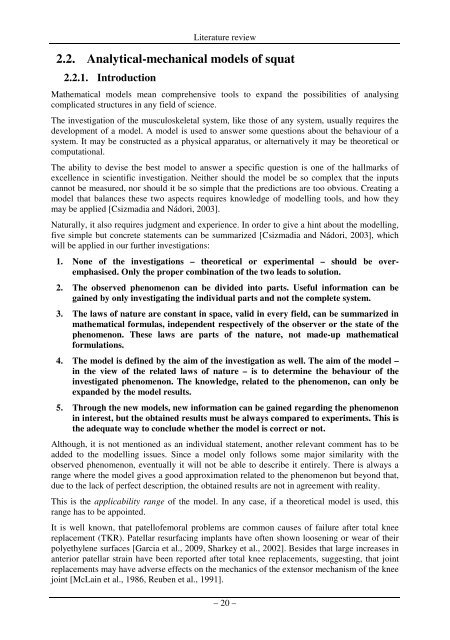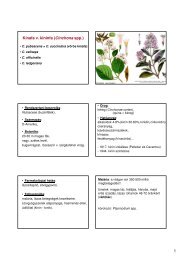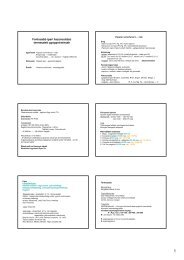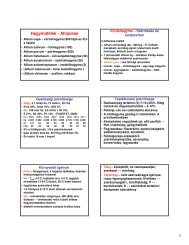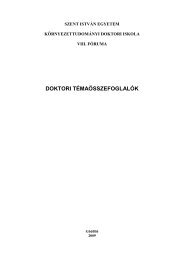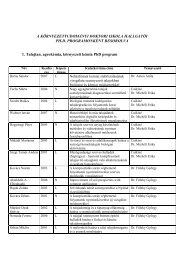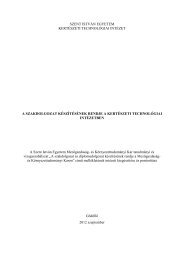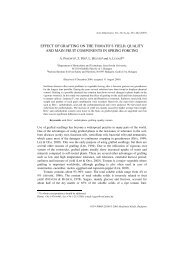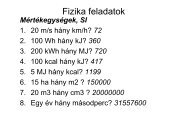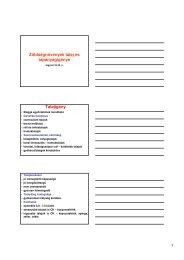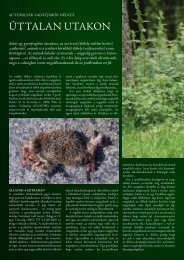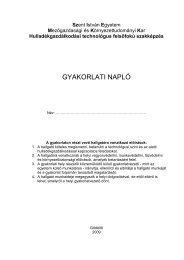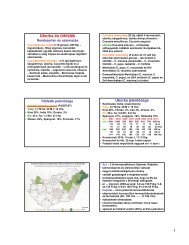PhD Fekete - SZIE version - 2.2 - Szent István Egyetem
PhD Fekete - SZIE version - 2.2 - Szent István Egyetem
PhD Fekete - SZIE version - 2.2 - Szent István Egyetem
You also want an ePaper? Increase the reach of your titles
YUMPU automatically turns print PDFs into web optimized ePapers that Google loves.
Literature review<br />
<strong>2.2</strong>. Analytical-mechanical models of squat<br />
<strong>2.2</strong>.1. Introduction<br />
Mathematical models mean comprehensive tools to expand the possibilities of analysing<br />
complicated structures in any field of science.<br />
The investigation of the musculoskeletal system, like those of any system, usually requires the<br />
development of a model. A model is used to answer some questions about the behaviour of a<br />
system. It may be constructed as a physical apparatus, or alternatively it may be theoretical or<br />
computational.<br />
The ability to devise the best model to answer a specific question is one of the hallmarks of<br />
excellence in scientific investigation. Neither should the model be so complex that the inputs<br />
cannot be measured, nor should it be so simple that the predictions are too obvious. Creating a<br />
model that balances these two aspects requires knowledge of modelling tools, and how they<br />
may be applied [Csizmadia and Nádori, 2003].<br />
Naturally, it also requires judgment and experience. In order to give a hint about the modelling,<br />
five simple but concrete statements can be summarized [Csizmadia and Nádori, 2003], which<br />
will be applied in our further investigations:<br />
1. None of the investigations – theoretical or experimental – should be overemphasised.<br />
Only the proper combination of the two leads to solution.<br />
2. The observed phenomenon can be divided into parts. Useful information can be<br />
gained by only investigating the individual parts and not the complete system.<br />
3. The laws of nature are constant in space, valid in every field, can be summarized in<br />
mathematical formulas, independent respectively of the observer or the state of the<br />
phenomenon. These laws are parts of the nature, not made-up mathematical<br />
formulations.<br />
4. The model is defined by the aim of the investigation as well. The aim of the model –<br />
in the view of the related laws of nature – is to determine the behaviour of the<br />
investigated phenomenon. The knowledge, related to the phenomenon, can only be<br />
expanded by the model results.<br />
5. Through the new models, new information can be gained regarding the phenomenon<br />
in interest, but the obtained results must be always compared to experiments. This is<br />
the adequate way to conclude whether the model is correct or not.<br />
Although, it is not mentioned as an individual statement, another relevant comment has to be<br />
added to the modelling issues. Since a model only follows some major similarity with the<br />
observed phenomenon, eventually it will not be able to describe it entirely. There is always a<br />
range where the model gives a good approximation related to the phenomenon but beyond that,<br />
due to the lack of perfect description, the obtained results are not in agreement with reality.<br />
This is the applicability range of the model. In any case, if a theoretical model is used, this<br />
range has to be appointed.<br />
It is well known, that patellofemoral problems are common causes of failure after total knee<br />
replacement (TKR). Patellar resurfacing implants have often shown loosening or wear of their<br />
polyethylene surfaces [Garcia et al., 2009, Sharkey et al., 2002]. Besides that large increases in<br />
anterior patellar strain have been reported after total knee replacements, suggesting, that joint<br />
replacements may have adverse effects on the mechanics of the extensor mechanism of the knee<br />
joint [McLain et al., 1986, Reuben et al., 1991].<br />
– 20 –


